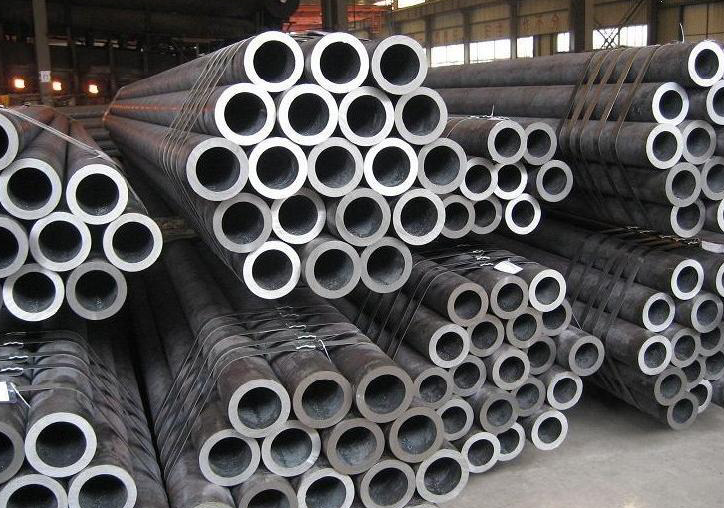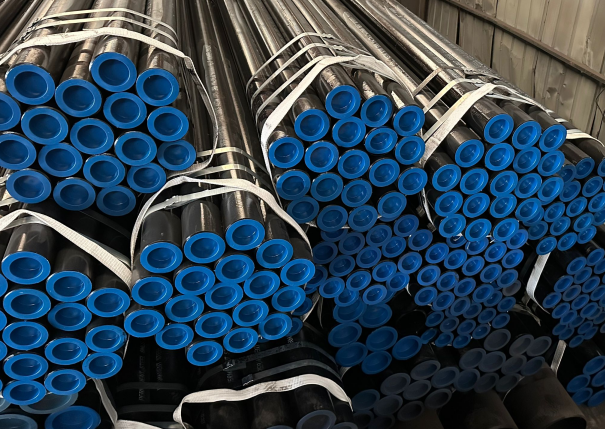
Types of Seamless Carbon Steel Pipes
Seamless carbon steel pipe is a kind of seamless pipe. Its material is carbon steel. It is characterized by its high strength, excellent corrosion resistance and good weldability. It is an important steel variety and is widely used in construction. , petroleum, chemical industry, machinery and other fields. Although there are many types of carbon steel pipe, they all share some key properties, including strength, hardness, and durability. Types of seamless carbon steel pipe vary by application, and each has a specific purpose. This article will explore the different types of seamless carbon steel pipes, their pros and cons, and best practices for using them.
Types of seamless carbon steel pipes:
The various types of seamless carbon steel pipes currently available can be divided into three major categories: hot-rolled seamless steel pipes (HRS), cold-rolled seamless steel pipes (CRS), and cold-drawn seamless steel pipes (CDS). Each category has several variants designed for specific applications (such as oil or gas transportation) or certain intensities.

Hot rolled seamless pipe
Hot-rolled seamless pipes are made from heated round steel billets and shaped into a cylindrical shape. They are typically used in engineering applications that require greater strength than cold rolled or CDS pipe. The heat treatment process makes them extra hard and strong, able to withstand high temperatures and pressure. Advantages of hot-rolled seamless pipe include cost-effectiveness, structural strength, and the ability to customize shapes. Disadvantages include their weight, which makes them difficult to transport and install. Hot rolled seamless pipe is often used in larger projects involving higher pressures and temperatures.
Cold rolled seamless pipe
Cold-rolled seamless pipes are made from hot-rolled steel formed by a series of rolls. Unlike hot rolled steel, cold rolled steel is harder and more brittle. It also allows for more precise machining and shaping, making it ideal for equipment that requires precision. Advantages of cold rolled pipe include higher corrosion and wear resistance, better machinability and lower cost. Disadvantages of cold-rolled pipe include lack of strength compared to hot-rolled steel, greater potential for cracking, and limited customizability. Cold-rolled pipe is typically used in smaller applications that don't require much strength or precision.
Cold drawn seamless pipe is made by forcing hot rolled pipe through one or more dies. This forces the material to become denser, making it stronger. They are ideal for applications where strength and pressure resistance are critical, such as automotive hydraulic lines and pipes. The advantages of cold-drawn seamless pipe include high strength, low cost, and the ability to produce precise shapes. Disadvantages include their potential to break if not properly tempered, lack of flexibility, and limited customizability. Cold drawn seamless pipe is most commonly used in automotive and industrial applications.
Manufacturing process of seamless carbon steel pipe:
The raw material for seamless carbon steel pipes is round tube billets. The round tube billets are cut by a cutting machine into billets with a length of about 1 meter and sent to the furnace for heating via a conveyor belt. The billet is fed into the furnace and heated to a temperature of approximately 1,200 degrees Celsius. The fuel is hydrogen or acetylene. Temperature control in the furnace is a critical issue. After the round tube is released from the furnace, it must be pierced through a pressure punching machine. Generally, the more common piercing machine is the tapered roller piercing machine. This type of piercing machine has high production efficiency, good product quality, large perforation diameter expansion, and can penetrate a variety of steel types.After perforation, the round tube blank is successively cross-rolled, continuous rolled or extruded by three rollers. After extrusion, the pipe should be removed and calibrated. The sizing machine rotates a tapered drill bit at high speed into the steel blank to drill holes to form a steel pipe. The inner diameter of the steel pipe is determined by the outer diameter length of the drill bit of the sizing machine. After the steel pipe is sized, it enters the cooling tower and is cooled by spraying water. After the steel pipe is cooled, it will be straightened. After straightening, the steel pipe is sent to the metal flaw detector (or hydraulic test) by the conveyor belt for internal flaw detection. If there are cracks, bubbles and other problems inside the steel pipe, they will be detected. After quality inspection, steel pipes must undergo strict manual selection. After the quality inspection of the steel pipe, spray the serial number, specification, production batch number, etc. with paint. And it is hoisted into the warehouse by a crane.
Seamless carbon steel pipes are classified according to the production process: seamless steel pipes are divided into two categories: hot-rolled and cold-rolled (drawn) seamless steel pipes.
In addition to general steel pipes, low- and medium-pressure boiler steel pipes, high-pressure boiler steel pipes, alloy steel pipes, stainless steel pipes, petroleum cracking pipes, and other steel pipes, cold-rolled (rolled) seamless steel pipes also include carbon thin-walled steel pipes, alloy thin-walled steel pipes, Stainless thin-walled steel pipes, special-shaped steel pipes. The outer diameter of hot-rolled seamless steel pipes is generally greater than 32mm, and the wall thickness is 2.5-75mm. The outer diameter of cold-rolled seamless steel pipes can be up to 6mm, and the wall thickness can be up to 0.25mm. The outer diameter of thin-walled pipes can be up to 5mm, and the wall thickness is less than 0.25mm. Cold rolling has higher dimensional accuracy than hot rolling.

General seamless carbon steel pipes: are made of hot-rolled or cold-rolled high-quality carbon structural steels such as 10, 20, 30, 35, 45, 16Mn, 5MnV and other low-alloy structural steels, or 40Cr, 30CrMnSi, 45Mn2, 40MnB and other alloy steels. Seamless pipes made of 10 and 20 grade low carbon steel are mainly used for fluid transportation pipelines. Seamless tubes made of medium carbon steel such as 45 and 40Cr are used to manufacture mechanical parts, such as stressed parts of automobiles and tractors. Generally, seamless steel pipes must ensure strength and flattening tests. Hot-rolled steel pipes are delivered in a hot-rolled or heat-treated state; cold-rolled steel pipes are delivered in a heat-treated state.
Seamless steel pipes for low and medium pressure boilers: used to manufacture various low and medium pressure boilers, superheated steam pipes, boiling water pipes, water-cooled wall pipes and superheated steam pipes, large smoke pipes, small smoke pipes and arch brick pipes for locomotive boilers, etc. Hot-rolled or cold-rolled (drawn) seamless steel pipes are made of high-quality carbon structural steel. Mainly made of No. 10 and No. 20 steel, in addition to ensuring the chemical composition and mechanical properties, hydrostatic tests, curling, flaring, flattening and other tests are required. Hot-rolled products are delivered in a hot-rolled state, and cold-rolled (rolled) products are delivered in a heat-treated state.
High-pressure boiler steel pipes (seamless boiler tube): High-quality carbon structural steel, alloy structural steel and stainless heat-resistant steel seamless steel pipes are mainly used to manufacture steam boiler pipes of high pressure and above. These boiler pipes often work under high temperature and pressure. The pipe will also undergo oxidation and corrosion under the action of high-temperature flue gas and water vapor. Therefore, the steel pipe is required to have high lasting strength, high oxidation resistance, and good organizational stability. The steel grades used are: high-quality carbon structure Steel grades include 20G, 20MnG, 25MnG; alloy structural steel grades 15MoG, 20MoG, 12CrMoG, 15CrMoG, 12Cr2MoG, 12CrMoVG, 12Cr3MoVSiTiB, etc.; rusty and heat-resistant steel commonly used 1Cr18Ni9, 1Cr18Ni11Nb high-pressure boiler tubes in addition to ensuring chemical composition and mechanical properties , it is necessary to conduct hydraulic pressure test one by one, as well as expansion and flattening tests. Steel pipes are delivered in heat treated condition. In addition, there are also certain requirements for the microstructure, grain size, and decarburization layer of the finished steel pipe.
Seamless steel pipes for geological drilling and oil drilling: In order to explore the underground rock structure, groundwater, oil, natural gas and mineral resources, drilling rigs are used to drill wells. The exploitation of oil and natural gas is inseparable from well drilling. Seamless steel pipes for geological drilling and oil drilling are the main equipment for drilling, mainly including outer core pipes, inner core pipes, casing pipes, drill pipes, etc.Since drilling pipes have to go deep into the stratum of several thousand meters, the working conditions are extremely complex. The drill pipes are subjected to stresses such as tension, pressure, bending, torsion and uneven impact loads, as well as mud and rock wear. Therefore, pipes are required to It must have sufficient strength, hardness, wear resistance and impact toughness. The steel used for steel pipes is represented by "DZ" (the Chinese pinyin prefix for geology) plus a number one to represent the steel yield point. Commonly used steel grades include DZ45 45MnB and 50Mn; DZ50’s 40Mn2, 40Mn2Si; DZ55’s 40Mn2Mo, 40MnVB; DZ60’s 40MnMoB, DZ65’s 27MnMoVB. Steel pipes are delivered in heat-treated condition.
Petroleum cracking tubes: Seamless tubes for furnace tubes, heat exchanger tubes and pipelines in petroleum refineries. Commonly used are high-quality carbon steel (10, 20), alloy steel (12CrMo, 15CrMo), heat-resistant steel (12Cr2Mo, 15Cr5Mo), stainless steel (1Cr18Ni9, 1Cr18Ni9Ti). In addition to verifying the chemical composition and various mechanical properties of steel pipes, steel pipes must also ensure water pressure, flattening, flaring and other tests, as well as surface quality and non-destructive testing. Steel pipes are delivered in heat treated condition. Stainless steel pipes: Hot-rolled and cold-rolled stainless steel pipes made of various stainless steels are widely used in petroleum and chemical equipment pipelines and stainless steel structural parts for various purposes. In addition to ensuring the chemical composition and mechanical properties, any steel pipe used to withstand fluid pressure It is necessary to ensure that the hydraulic pressure test is qualified. Various special steel pipes must ensure conditions according to regulations.
Applications of seamless carbon steel pipes:
Seamless steel pipe is a very important type of steel that is widely used in various fields.
1. Construction field
Seamless steel pipes are widely used in the construction field. They are mainly used in important structures such as high-rise buildings, cold storages, and roof waterproofing to play load-bearing and waterproofing functions.
2. Petroleum field
Seamless steel pipes are also widely used in the petroleum field, mainly used in the construction and installation of petroleum pipelines, petroleum storage tanks and other equipment. Seamless steel pipes are widely used because of their corrosion resistance, high temperature resistance, and high pressure resistance.
3. Chemical industry
Seamless steel pipes are also widely used in the chemical industry, mainly used to transport ammonia, urea, methanol and other chemical raw materials. Since these media are often corrosive, seamless steel pipes are required to ensure safe operation of the pipelines.
4. Mechanical field
Seamless steel pipes are also widely used in the mechanical field (seamless mechanical tubing), mainly used to manufacture parts for automobiles, tractors and other agricultural machinery. Seamless steel pipes are widely used because of their high strength and corrosion resistance.
Conclusion:
Seamless carbon steel pipes are widely used in construction, petroleum, chemical industry, and machinery fields. Each type of pipe serves specific needs and applications, so it's important to understand their advantages and disadvantages before using them in a project. Hot-rolled seamless pipe is the most cost-effective and widely available, while cold-rolled and cold-drawn pipe are more precise and offer greater strength and resistance. No matter which type of seamless carbon steel pipe is chosen, proper installation, handling and maintenance will ensure the longevity of any project.


